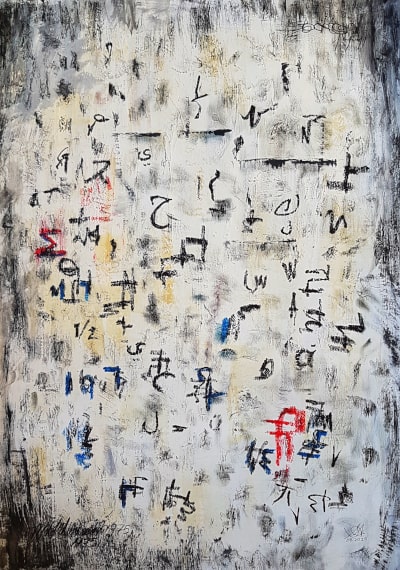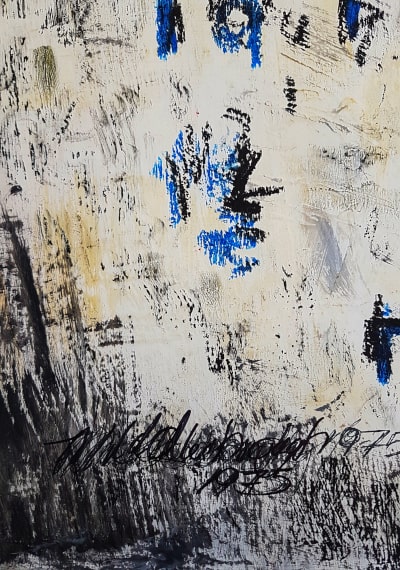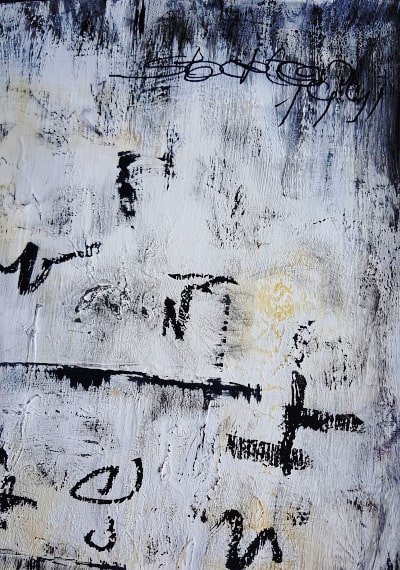What We Retain, What We Forget: From Memoir to Mixed Media Art
A few weeks ago, I began the journey of writing my personal memoir. As I wrote, I found myself drifting in and out of different periods, with some memories arriving vividly and others fading like distant echoes.
This unpredictable nature of memory was what inspired my mixed media artwork What We Retain, What We Forget. It’s a large piece, made on archival paper card measuring 594 x 841 millimetres (23.4 x 33.1 inches) and part of my painting project for this year.

From Memory to Mixed Media Art
Just like my memoir, the painting didn’t happen all at once. My process for this work unfolded in three distinctive sections, as usual – the background, the middle ground and the foreground. Each section is made up of several layers, each layer adding its own history, texture and mood before I move on to the next stage.
- The background began in acrylic, creating a foundation of colour and atmosphere. I chose warm earthy colours. Colours that remind me of childhood summers and the way light filtered through our old kitchen window near the sea.
- The middle ground added more depth and texture, building a sense of space and underlying time. Here, I introduced some letters, not complete words, from travels to Cyprus, Malaysia, Japan and elsewhere, pieces that carry their own stories.
- The foreground, worked in oil pastels, became the place for bolder marks, scratches and symbolic gestures. These marks became my visual vocabulary for half-remembered conversations and feelings that resist translation into words.
Each section took time, effort and a lot of emotional engagement. Some days the painting felt like a conversation with myself, other days like an excavation – uncovering things I didn’t expect to find.
Why Mixed Media Art Speaks to Memory
The choice to work across different media wasn’t arbitrary. Memory itself is layered, isn’t it? We remember through our senses – the texture of a jumper, the sound of rain on glass, the smell of wood smoke. Mixed media art allows me to capture these different sensory experiences within a single piece.
The acrylic base provides structure, much like the factual framework of our memories. The middle ground elements represent the tangible proof of our experiences, whilst the oil pastels become the emotional overlay, the feelings that colour how we remember.
Inviting a Closer Look: The Details That Matter
Throughout this piece, I want to draw your attention to the importance of intimate viewing in mixed media art. When you step back, you see the overall composition – the flow of colour and form. But it’s in the close-up examination where mixed media art truly reveals itself.

In the lower left corner, you’ll find layers of text partially obscured by translucent washes of paint. A place and a date that means so much to a change in my life – now illegible but still present, much like how we retain the emotional weight of words long after we’ve forgotten their precise meaning.
The upper right section contains what I call “ghost marks” – another place and date that changed the direction of my life. They create a palimpsest effect, where previous layers of information show through, creating depth and suggesting the archaeology of memory.

Abstract or Asemic: When Mixed Media Art Becomes Language
I’ve always identified as an abstract artist and that’s what I set out to make here. However, working in this mixed media piece has led me into unexpected territory. I know very little about “asemic art”, but I started to wonder if some people might see those qualities in this piece too.
Asemic art, put simply, is art that looks like writing but has no fixed meaning. The marks can resemble letters, numbers or symbols, but they’re not meant to be read in the usual sense. Instead, they invite viewers to make their own interpretation.
In What We Retain, What We Forget, my marks aren’t actual words – they’re more like traces of thought, fragments of feeling triggered through the process of writing my memoir. Some are bold and confident, others faint or half-erased. The mixed media approach amplifies this effect – where acrylic meets pastel, a visual language emerges that feels familiar yet impossible to decode.
My Wife’s Reaction
I spent several days making this painting, which I began to see while writing my memoir. It may look simple, but believe me, the amount of emotional effort that went into that painting was huge.
When I first showed the painting to my wife, she was so stunned. I’ve never seen her expression like that before. “It’s so different”, she said. “There’s something so deep behind the layers – you’re definitely writing a story here”, she continued.
I must admit that it’s a new style I’ve never used before.

The Technical Journey: Challenges in Mixed Media Art
Working across multiple media presents unique technical challenges that I think are worth sharing. Each material has its own drying time, its own way of interacting with the surface and with other materials.
Acrylics dry quickly, which is perfect for building up base layers rapidly. However, this can work against you when you want to blend or work wet-into-wet.
Oil pastels, conversely, never fully dry, which means they can be reworked almost indefinitely but also risk muddying if you’re not careful about how you layer them.
Perhaps most challenging is knowing when to stop. In traditional painting, there’s often a clear sense of completion. In mixed media art, there’s always another layer you could add, another material you could introduce. Learning to recognise the moment of balance when all elements are working in harmony is crucial.
Art as a Storyteller: The Narrative Power of Mixed Media
This painting connects closely with ideas I explored in my earlier blog Storytelling Through Abstract Painting. Abstract art doesn’t tell stories in the way a novel does, but it can still carry narratives – through colour, form and texture. Mixed media art takes this further, allowing multiple narrative threads to coexist within a single work.
The layered elements bring their own stories – marks that speak of journeys, fragments that carry echoes of particular moments. These narrative fragments don’t need to connect logically; they operate more like memory itself, where seemingly unrelated elements can be bound together by emotion or circumstance.
In another blog, Painting Your Feelings, I wrote about how art can capture emotions in a way that’s often hard to put into words. I think this mixed media piece sits at the meeting point between storytelling and emotion – a visual memoir that blends narrative and feeling without needing literal representation.

The Broader Context: Mixed Media Art in Contemporary Practice
It’s worth noting that mixed media art isn’t new – artists have been combining materials for centuries. However, our current moment feels particularly suited to this approach. We live in an age of information overload, where our daily experience is already a collage of digital and physical, old and new, local and global.
Mixed media art reflects this contemporary condition. It acknowledges that our experiences don’t come in neat categories and neither should our art. The challenge lies not in justifying the approach, but in making it meaningful, ensuring that each element serves the larger purpose rather than simply adding complexity for its own sake.
A Personal Reflection: What Mixed Media Art Teaches Us
Working on this piece has taught me something important about both memory and art-making. Memory isn’t a single, coherent narrative – it’s a layered accumulation of experiences, emotions and impressions. Similarly, mixed media art succeeds when it embraces this complexity rather than trying to resolve it.
There’s something liberating about accepting that not everything needs to be perfectly integrated or immediately readable. Sometimes the power lies in the gaps, the contradictions, the places where different elements don’t quite align. These are the spaces where viewers can enter the work and find their own meanings.
Your Turn: What Material Would You Choose For Your Memories?
I’d like to leave you with a question that’s been guiding my work: if you could turn your own memories into art, what materials would you choose? Would they be permanent or ephemeral, smooth or textured, transparent or opaque?
Mixed media art suggests that perhaps we don’t need to choose – that the richness of our experience deserves an equally rich range of materials to express it. The challenge is learning to orchestrate them into something coherent yet surprising, familiar yet strange – rather like memory itself.





13 August 2025 @ 6:32 pm
It’s always a good day when I see you have uploaded a new blog post. 👍😊
I made notes while I read, so if I say something that you cover later, that is why.
I am so happy to hear that you have started your memoirs. I hope that you find the experience enlivening. When I wrote mine, it was the most wonderful experience, even examining some of the more difficult times.
I love your “What We Retain, What We Forget full view” piece. Knowing the background, in the sense of where it stems from, and seeing the asemic nature of the piece sings loudly to me. I wonder if the red bits symbolize the painful experiences in your life, the blue perhaps the exceptionally happy times.
The hidden text is brilliant, and the way you shadow it in a somewhat fading memory kind of way. I find memory can be a bit tricky for a number of reasons. Do I remember something because I saw it in an old photo, or do I remember it as a real occurrence? Are my memories clouded because of my feelings at the time, or now in retrospect? Probably a combination of both. Other things too.
As I continue to read, I see the true artist that you are – bringing your inner self to life on the canvas. Digging deep – exploring the recesses of your mind and utilizing your talent to share your vision. This piece may be different from what you have done in the past, as your wife suggested, but I think it maintains the abstract, while adding a new asemic element, which you have been pondering more recently. I find that too, when I am looking at the art around me, and I am inspired, I can’t help but work that into my own art.
I love the idea of mixed media. You seem to have the technical skill to make that work with your traditional mediums. A skill for sure!
So well said, “Memory isn’t a single, coherent narrative – it’s a layered accumulation of experiences, emotions and impressions.”
Thanks for the mindful and inspirational post, Suhail!
15 August 2025 @ 9:43 am
Thank you so much, Don, for reading my blog and for your thoughtful comment.
To be honest, writing my memoir hasn’t been the easiest journey. I’ve done it for the kids so they can know about parts of our family history they haven’t lived through or maybe don’t even know about.
I’d like to pass those stories on to the next generation and, who knows, maybe they’ll feel inspired, as my daughter suggested, to pick up where I left off and add their own chapters for those who come after them.
I’m glad you connected with “What We Retain, What We Forget”. The image came to me so vividly while I was writing the memoir. It was a surprise because it’s nothing like what I’ve painted before.
For me, red is an “attention seeker”. It marks the times in life that demanded a lot of focus. The blue parts were those periods when things started to settle down, moments of stability and solid ground.
I appreciate what you said about the asemic element and mixed media. I think they can add another language to any artwork.
Thanks again for your kind words and for sharing your own reflections on memory and art.